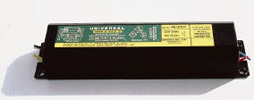Contact EPA Pacific Southwest Cleanup
Pacific Southwest, Region 9
Serving: Arizona, California, Hawaii, Nevada, Pacific Islands, Tribal Nations
Storage & Disposal: Ballasts


On this page:
PCBs were commonly used in the small capacitor within fluorescent light ballasts. Ballasts manufactured through 1979 may contain polychlorinated biphenyls (PCBs).
PCB containing ballasts become a concern if they are leaking or they will be removed and disposed of as hazardous waste. According to EPA Toxic Substances Control regulations (TSCA) the material must be incinerated. The entire lighting fixture does not need special handling and disposal as long as the ballast (electrical box) is not leaking. The non-leaking ballasts can be removed and recycled or disposed of properly.
PCB Lighting Ballasts in Schools
The California Department of Education (CDE) and Department of Toxic Substances Control (DTSC) recommend removal of pre-1979 PCB ballasts from schools as soon as practicable. They recommend that school districts planning modernization projects should include PCB fluorescent light ballast removal where pre-1979 lighting systems are still in use.
Fluorescent light ballasts manufactured before 1978 or which are not stamped: "NO PCBs" should be considered PCB fluorescent light ballasts (PCB ballasts) because the small capacitor included as one component of the ballast probably contains polychlorinated biphenyls (PCB).
PCB lighting ballasts remain in use in schools throughout the country. As this equipment ages, it is critical that school personnel are aware of how to properly handle and dispose of ballasts.
Should you consider replacing light ballasts in your school?
Yes, if your school:- was built before 1979 or,
- has not had a complete lighting retrofit since 1979.
EPA has developed two guides to help schools manage PCBs in lighting ballasts and conduct a lighting retrofit. Because the ballasts contain PCBs and the fluorescent tubes contain mercury, safe disposal of the old ballasts and fluorescent tubes is critical.
• A Guide for School Administrators
Removing PCBs from Light Fixtures: Protecting Students from Hidden Dangers (PDF) (8 pages, 2.1 MB) An overview of proper management of lighting ballasts, case studies of clean up and retrofit experiences at other schools, information resources for lighting retrofits, and answers to questions from parents and students.
• A Guide for School Maintenance Personnel
Removing PCBs from Light Fixtures: Protecting Students from Hidden
Dangers (PDF) (10 pages, 3.7 MB) Detailed information on identifying PCB ballasts, emergency response and follow-up in case of a ballast fire and leak, proper disposal of ballasts and lamp tubes, and guidance and resources for designing and conducting a lighting retrofit.
NOTE: You will need Adobe Acrobat Reader to view these files. See EPA's PDF page to learn more.
Additional Ballast Resources
More information on PCBs in schools, energy efficiency, children's health issues and healthy school facilities:
TSCA Disposal Requirements for fluorescent light ballasts (PDF)
EPA's Energy Star Program
General info on energy efficient lighting retrofits.
California
Energy Commission's Bright Schools Program ![]()
(916) 654-5074
This program offers specific services to help you become more energy wise,
such as identifying cost-effective energy-efficient systems to meet your
needs providing design, technical and implementation assistance. The program
can also help you get loans to obtain the matching funds required by some
State programs.
